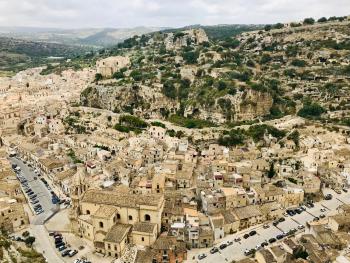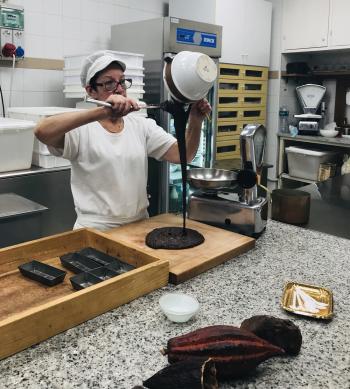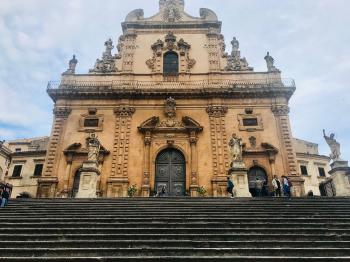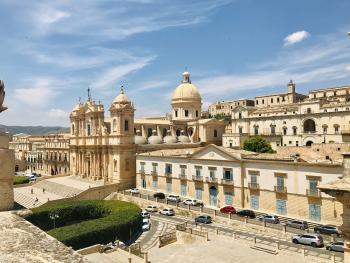Stepping back in time in the Baroque towns of Sicily’s Val di Noto
This article appears on page 6 of the November 2019 issue.
When visiting the popular Sicilian tourist destinations of Palermo, Taormina, Mt. Etna, Catania and Syracuse, you’ll find modern comforts, but if you visit the Val di Noto (Noto Valley) of southeast Sicily, turn your watch back 50 years and be prepared for a laid-back, informal and super-friendly experience in the towns of Noto, Modica and Scicli, UNESCO World Heritage Sites known for their late-Baroque architecture and archaeological heritage.
“We’re welcoming and very tourist-friendly but, below the surface, private people,” said Eugenia Giunta (eugeniagiunta@gmail.com), an “experience designer” with Mutika, a company that arranges travel and events for businesses and individuals. “It helps to know someone who lives here, a friendly host who can open a few doors for you.”
My wife, Maria, and I were put in touch with Eugenia by mutual Italian friends, and she gave new meaning to the words “friendly hostess.”
Noto
We landed in Catania in late May 2019, then headed by bus to Noto, just a 90-minute ride away. (Except for one trip, from then on we did all our intercity traveling using the area’s convenient bus service.)
After arriving in Noto, we visited the famous, elaborate Cathedral of San Nicolò. Rebuilt over 10 years starting in 1996, it featured an interesting mixture of ancient and modern artifacts and stained-glass windows. We also stopped at the Civic Theater, which resembled a giant child’s toy box, and toured the beautiful Palazzo Ducezio, with its Versailles-like Hall of Mirrors and panoramic terrace.
Noto is best known internationally for its annual Infiorata di Noto competition, during which a steep street just off the Corso Vittorio Emanuele is transformed into a floral mosaic decorated with millions of flower petals by participants, each of whom is assigned a small portion of the street to show their decorative skills. The event attracts thousands of tourists during the third weekend in May, so we planned our visit for a less hectic time, a week after the festival.
We stayed at the very comfortable 9-room San Pietro B&B (Via A. Cosenza, 9; www.bbsanpietro.it), just a 10-minute walk from Corso Emanuele. It had the most friendly and helpful staff we have ever experienced. (Rooms cost €60-€80, or $66-$88, depending on the season.)
The owner, Salvatore, spoke no English, but one of the English-speaking breakfast staff appeared each morning to help with breakfast and cater to the non-Italian-speaking guests. Salvatore will even pick up and deliver guests to the bus or train stops when he can, and the staff provided a daily sardine-and-cheese baguette as a takeaway lunch.
Modica
We had planned to travel to Modica, known as the most Baroque city in Sicily and the historic capital of the Noto Valley, on the Sunday after our arrival, but one of the hotel’s staff members explained that, as far as trains, buses and taxis were concerned, in that part of Sicily it was “never on Sunday.”
So we took a late-afternoon train to Modica on Saturday and taxied to Casa Talía (Via Exaudinos, 1/9; www.casatalia.it), as recommended by Eugenia. This 11-room complex, built high on the city’s south-side mountain, had spacious, modern rooms built into the mountain rock and featured terraces overlooking the center of the city plus excellent service — well worth the €160 nightly charge.
The pleasant 15-minute walk down to the town center involved a winding trail and over 250 steps, but the hike back up is not for the faint of heart, so we got to know the four taxi drivers in town quite well.
We walked down to Corso Umberto, the main street, and found that most of the places of interest we wanted to visit were on or just off this street.
Modica is known for its chocolate and fine food. At Ornato Ristorante di Pesce (30 Via Pozzo Barone), we dined on excellent seafood, fried sesame bread, a mixed appetizer and wine for €80 for the two of us. (We skipped the menu specials of horse and donkey meat.)
After breakfast the following morning we hopped on the Old Town green-line Trenino Barocco mini-train (€5), which provided a pleasant, though occasionally jarring, tour around the key downtown sites plus some on the north mountain. (The red-line tour around the south mountain proved more jarring and less worthwhile, except for the stop for a panoramic view on top of the mountain.)
Chocolate and churches
Modica is best known in Europe for its distinctive chocolate, made in the tradition of the ancient Aztecs. (Chocolate was brought back to Sicily from Mexico by the Spanish, who ruled Sicily in the 16th century.) The city’s chocolate makers produce, we were told, some 2.5 million bars yearly.
Many of the chocolate gift shops featured dazzling arrays of chocolate bars in most every flavor imaginable, from apple, blueberry, cardamom and donkey milk (!) to salt, tamarind, ugli (citrus), vanilla and wine.
We hurried to Antica Dolceria Bonajuto (Corso Umberto 1), which has been making the grainy, intense chocolate in the ancient way since 1880, attracting chocolate lovers from all over the world. Eugenia had booked a late-morning kitchen demonstration for us (€3).
After donning clean-room garb, we were shown the Bonajuto interpretation of this handmade bean-to-bar ancient art and sampled a few of the many flavors.
For the next day and a half we visited many of the churches, pocket museums and historic Baroque buildings that dot the city.
The Cathedral San Pietro, a UNESCO site, featured a huge entrance staircase adorned with statues of the 12 apostles and, inside, sculptures, frescoes, works of art and an inlaid marble floor.
The spectacular Baroque Duomo of San Giorgio is the mother church of the city. Accessible from Corso Umberto via an elegant 260-step staircase, the church features a magnificent dome overlooking the city. The interior includes historic paintings, wood porticos, sculptures, ancient silverwork, a magnificent full-functioning 18th-century pipe organ and a 19th-century sundial featuring the 12 zodiac symbols.
The Gothic-style cloister of Santa Maria del Gesù, restored from a series of convents, churches and prisons (completed in 2010), is a 10-minute ride outside the town center and also worth a visit.
Along Corso Umberto
The Garibaldi Theater on Corso Umberto, built in 19th-century neoclassical style, contains a beautifully decorated ceiling and walls that can be viewed between performances and rehearsals at no charge.
Just off the town center is the Tommaso Campailla Medical Museum, an excellent stop for health care professionals. The museum, built as the first hospital in the city, preserves the instrument and equipment collection of Campailla, a pioneering medical philosopher.
For dinner that night, we accompanied Eugenia to Cappero Bistrot (Corso Umberto I, 156; cappero bistrot.com), where her friend Chef Antonio Pennacchio prepared an outstanding meal of mixed appetizers that included arancini, ricotta cheese, hazelnut gnocchi and mushroom toast and excellent entrées of pasta with pork cheeks and pasta with veal meatballs. Our dinners with two wines cost €60.
Following dinner, Eugenia took us to the highest point in the city, the north mountain lookout adjacent to St. John church, where we viewed the thousands of dazzling lights that dramatically outlined the city at night. It was a wonderful way to cap our last night in Modica.
Scicli
We decided to spend our last day in the area in Scicli, arguably the prettiest small city in Italy, just a 40-minute bus ride from Modica. We asked the bus driver to let us off close to the city center, where we found ourselves on a quiet corner adjacent to a small park.
Having no idea of how to proceed, I spotted a group of elderly men smoking and talking on a nearby bench. I asked if anyone spoke English, and two men jumped up saying “A little.”
After explaining where we wanted to go, one of the men pointed to a series of streets and turns but was interrupted by the second man, who loudly pointed out a different route. A heated argument between the two commenced, and after three or four minutes my wife and I decided it was best to quietly leave and proceeded according to the first recommendation.
We had walked maybe five minutes when we heard hurried footsteps behind us. We were quickly separated by one of the arguing gentlemen, who gently looped his arms in ours, saying, “He crazy. I take you.” And so he did.
Scicli is off the beaten track, even compared to its neighbors Noto and Modica. Sciclians were once cave dwellers living under the protection of the Church of San Matteo on the south mountain overlooking the town. The town became part of Italy in the mid-19th century, and by the early 20th century, the inhabitants had moved downhill to settle around the city’s valley center.
The now-abandoned church and caves are attractions for hikers, especially those interested in archaeology. There is an open-air archaeological park located a 15-minute walk away from the town center.
In town we visited Piazza Italia, a large square lined with elegant historic Baroque buildings, churches, palaces, cafés and restaurants, and walked along Via Mormino Penna, a pedestrian-friendly street. Highlights on or adjacent to Via Penna include the Church of Santa Maria la Nova, with its huge Neoclassic façade; the Baroque San Bartolomeo church, with a giant dome overlooking the town center; the San Giovonni Evangelista Church, which houses the “Christ of Burgos” painting depicting a crucified Christ wearing sacerdotal robes in white and various shades of gray, and the Mother Church of Sant’Ignazio, which houses the highly venerated image of “Madonna dei Milici,” unique in that it is likely the only historic painting of the Holy Virgin on a white horse, armed with a sword.
We toured the Spadaro Palace, one of the most elegant palaces in Sicily, whose vast rooms feature Baroque decorations, giant chandeliers and stately balconies with interesting iron railings.
The immediate area also includes the charming Costume Museum, housing a lovely collection of historic costumes, and the Antica Farmacia Cartia, which highlights apothecary history, with displays of equipment, furniture, scales and an ancient cash register.
A 10-minute drive took us to the Complesso Santa Maria della Croce, overlooking the town from the southern hills. A former monastery, convent and church, the lovely site is built around two giant courtyards, and it was perfect for a quiet walk offering lovely views of the city, the Church of San Matteo and the caves below.
Heading back to Catania by bus to take our flight home, we agreed that this very different southeast section of Sicily was a wonderful complement to the more tourist-oriented northern and western sections of the island.




